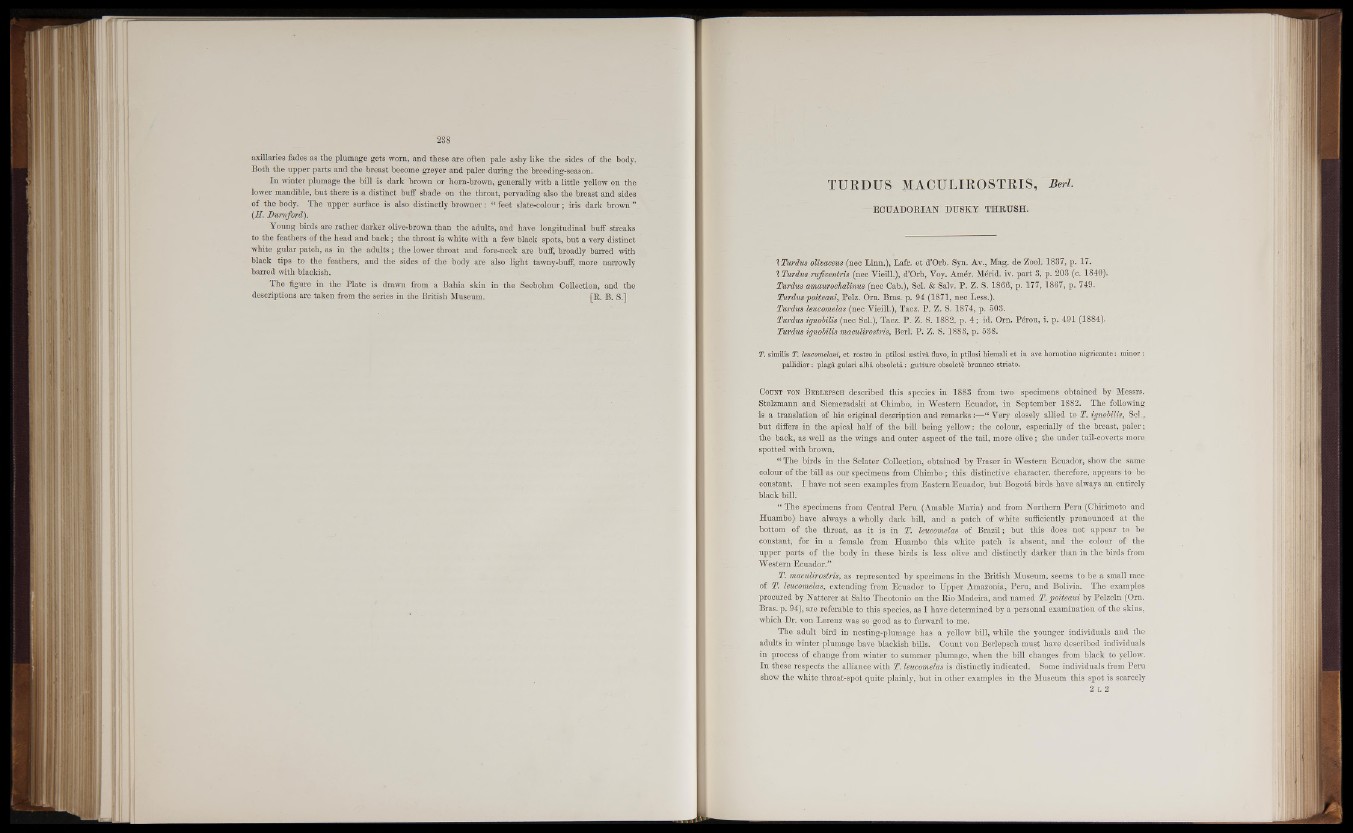
axillaries fades as the plumage gets worn, and these are often pale ashy like the sides of the body.
Both the upper parts and the breast become greyer and paler during the breeding-season.
In winter plumage the bill is dark brown or horn-brown, generally with a little yellow on the
lower mandible, but there is a distinct buff shade on the throat, pervading also the breast and sides
of the body. The upper surface is also distinctly browner: “ feet slate-colour; iris dark brown ”
(H. Dumford).
Young birds are rather darker olive-brown than the adults, and have longitudinal buff streaks
to the feathers of the head and back; the throat is white with a few black spots, but a very distinct
white gular patch, as in the adults; the lower throat and fore-neck are buff, broadly barred with
black tips to the feathers, and the sides of the body are also light tawny-buff, more narrowly
barred with blackish.
The figure in the Plate is drawn from a Bahia skin in the Seebohm Collection, and the
descriptions are taken from the series in the British Museum. [R. B. S.]
TURDUS MACULIROSTRIS, Berl.
ECUADORIAN DUSKY THRUSH.
% Turdus olivaceus (nec Linn.), Lafr. et d’Orb. Syn. Av., Mag. de Zool. 1837, p. 17.
1 Turdus rufiventris (nec Vieill.), d’Orb, Voy. Amer. Merid. iv. part 3, p. 203 (c. 1840).
Turdus amaurochalinus (nec Cab.), Scl. & Salv. P. Z. S. 1866, p. 177, 1867, p. 749.
Turduspoiteaui, Pelz. Orn. Bras. p. 94 (1871, nec Less.).
Turdus leucomelas (nec Vieill.), Tacz. P. Z. S. 1874, p. 503.
Turdus ignobilis (nec Scl.), Tacz. P. Z. S. 1882, p. 4; id. Orn. Perou, i. p. 491 (1884).
Turdus ignobilis maculirostris, Berl. P. Z. S. 1883, p. 538.
T. similis T. leucomelani, et rostro in ptilosi sestiv& flavo, in ptilosi hiemali et in ave homotino nigricante: minor :
pallidior: plagS, gulari alM obsolete: gutture obsolete brunneo striato.
Count von B erlepsch described this species in 1883 from two specimens obtained by Messrs.
Stolzmann and Siemeradski at Chimbo, in Western Ecuador, in September 1882. The following
is a translation of his original description and r em a r k s “ Very closely allied to T. ignobilis, Scl.,
but differs in the apical half of the bill being yellow; the colour, especially of the breast, paler;
the back, as well as the wings and outer aspect of the tail, more olive; the under tail-coverts more
spotted with brown.
“ The birds in the Sclater Collection, obtained by Fraser in Western Ecuador, show the same
colour of the bill as our specimens from Chimbo ; this distinctive character, therefore, appears to be
constant. I have not seen examples from Eastern Ecuador, but Bogota birds have always an entirely
black bill.
“ The specimens from Central Peru (Amable Maria) and from Northern Peru (Chirimoto and
Huambo) have always a wholly dark bill, and a patch of white sufficiently pronounced at the
bottom of the throat, as it is in T. leucomelas of Brazil; but this does not appear to be
constant, for in a female from Huambo this white patch is absent, and the colour of the
upper parts of the body in these birds is less olive and distinctly darker than in the birds from
Western Ecuador.”
T. maculirostris, as represented by specimens in the British Museum, seems to be a small race
of T. leucomelas, extending from Ecuador to Upper Amazonia, Peru, and Bolivia. The examples
procured by Natterer at Salto Theotonio on the Rio Madeira, and named T. poiteaui by Pelzeln (Orn.
Bras. p. 94), are referable to this species, as I have determined by a personal examination of the skins,
which Dr. von Lorenz was so good as to forward to me.
The adult bird in nesting-plumage has a yellow bill, while the younger individuals and the
adults in winter plumage have blackish bills. Count von Berlepsch must have described individuals
in process of change from winter to summer plumage, when the bill changes from black to yellow.
In these respects the alliance with T. leucomelas is distinctly indicated. Some individuals from Peru
show the white throat-spot quite plainly, but in other examples in the Museum this spot is scarcely
2 L 2